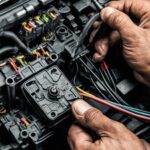The trouble code P0455 indicates a significant issue within your vehicle’s Evaporative Emission Control System (EVAP). This system is designed to prevent harmful fuel vapors from escaping into the atmosphere. When the engine control unit (ECU) detects a large leak in this system, it triggers the P0455 code and illuminates the check engine light. This code is a generic OBD2 code, meaning it applies to most modern vehicles, but specific repair steps can vary depending on the car’s make and model.
What is OBD2 Code P0455?
Essentially, a P0455 code signifies that your vehicle’s EVAP system has a “large leak.” This means there’s a substantial breach in the sealed system, preventing it from properly containing and managing fuel vapors. Different manufacturers may have slightly varying descriptions for this code, such as:
- Generic: Evaporative Emission Control System Leak Detected (no purge flow or large leak)
- Chrysler: EVAP Large Leak Detected Conditions
- Ford: EVAP System Leak (No Purge Flow or Large Leak) Conditions
- GM (Chevrolet): EVAP System Leak Detected Conditions
- Nissan: Evaporative emission (EVAP) canister purge system – gross leak
The EVAP system works by capturing fuel vapors in a charcoal canister and then purging them into the engine to be burned during normal operation. A large leak disrupts this process, leading to the P0455 code. This code is related to other EVAP system codes that indicate different types of leaks or malfunctions, such as P0450, P0451, P0452, P0453, P0454, P0456, P0457, P0458, and P0459, which often point to smaller leaks or specific component issues.
Symptoms of P0455
One of the most common aspects of the P0455 code is that you might not notice any significant changes in how your car drives. Unlike some engine codes that cause performance problems, a large EVAP leak typically doesn’t affect drivability. The primary symptom is the illuminated check engine light on your dashboard. In some cases, you might also notice a faint fuel odor, especially around the fuel filler cap area, but this is not always present.
Common Causes of P0455
The most frequent causes of a P0455 code are relatively simple to address:
- Loose or Missing Gas Cap: This is the most common culprit. If the gas cap isn’t tightened properly after refueling, or if it’s missing altogether, it can create a large leak in the EVAP system.
- Damaged or Incorrect Gas Cap: A gas cap that is cracked, has a worn seal, or isn’t the correct type for your vehicle can also fail to seal properly, triggering the P0455 code. Aftermarket gas caps that don’t meet factory specifications can sometimes be the issue.
- EVAP System Leaks: Beyond the gas cap, leaks can occur in various components of the EVAP system, including:
- Hoses and Tubing: Cracks, holes, or loose connections in the EVAP system’s hoses and tubing are common leak points.
- Charcoal Canister: Damage to the charcoal canister itself can lead to leaks.
- Purge Valve and Vent Valve: Malfunctioning valves can sometimes cause leaks, although they are more commonly associated with other EVAP codes.
- Fuel Tank Pressure Sensor: While less frequent for a large leak code, issues with the fuel tank pressure sensor or its seal could also contribute.
How to Diagnose and Fix P0455
Diagnosing and fixing a P0455 code can often be straightforward, starting with the easiest and most common fixes:
-
Check and Retighten the Gas Cap: Ensure your gas cap is securely tightened. Remove it and reinstall it, making sure it clicks into place. Clear the OBD2 codes using a scan tool and drive your car for a day or two to see if the code returns.
-
Inspect the Gas Cap: Examine the gas cap for any visible damage, such as cracks or a worn or cracked rubber seal. If it looks damaged, replace it with a new, factory-recommended gas cap.
-
Visual Inspection of EVAP System Hoses: Carefully inspect all accessible EVAP system hoses and tubing in the engine compartment and underneath the vehicle. Look for any cracks, breaks, or loose connections. You might be able to hear a vacuum leak or smell fuel near a larger leak. Repair or replace any damaged hoses or reconnect any loose fittings.
-
Professional Smoke Test: If the gas cap and hoses appear to be in good condition, the next step is often a professional smoke test of the EVAP system. This test involves using a specialized machine to introduce smoke into the EVAP system and identify the location of any leaks. This is usually performed by a qualified mechanic.
-
Component Testing and Replacement: Based on the results of a smoke test or further diagnosis, specific EVAP system components like valves or the charcoal canister may need to be tested and potentially replaced.
Conclusion
While a P0455 code might not immediately impact your vehicle’s performance, it’s important to address it promptly. A large leak in the EVAP system means fuel vapors are escaping, which is not only environmentally unfriendly but can also indicate a problem that could worsen over time. Starting with a simple gas cap check and visual inspection can often resolve the issue. If the problem persists, professional diagnosis will help pinpoint the exact cause and ensure a proper repair, keeping your car running efficiently and cleanly.
